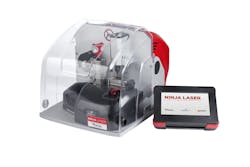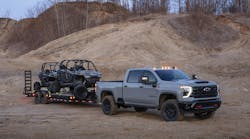A common feature of most key machines is that they have a single purpose. There are key machines for house keys and key machines for sidewinder keys but until recently there has never been a key machine which can originate both types of keys. The compact Ninja Laser key machine by Keyline has changed those old ideas and developed a key machine which can originate almost all of the edge type or sidewinder laser type keys sold in the North American market.
The Ninja Laser machine is controlled by a separate console with a touch screen similar in looks and usage to a computer tablet. First-time setup consists of connecting a cable from the console to a plug-in port In the Ninja Laser machine. Once the cable is connected and a console startup process is completed, the Ninja Laser is ready for action right out of the box.
The first screen displayed by the console allows the user to set a password to prevent unwanted use of the machine. For purposes of this article we will not describe how to set a password but will move instead into the many interesting features of the Ninja Laser machine.
A 'Main Menu' screen is where the action begins (photo 1). The screen is divided into eight sections: favorites, cars, codes, key blanks, archive, setup, search and personal computer.
The Ninja Laser is designed to cut keys by code and the "CODES" section simplifies this job. Each depth and space measurement contained in the Ninja Laser has its own card number. If you know the Keyline, Instacode or generic card number, the console will display all code series which use that card number. Another search function is by a cylinder manufacturer name. When All-Lock is chosen (photo 2) the screen displays the available All-Lock code series (Photo 3). Additional screen displays show which vise jaw to use and how to install the key blank into the vise jaw (photo 4). A drawing of the finished key can also be displayed (photo 5).
"CARS" is another helpful choice on the console. Press "CARS" on the touchscreen and an extensive list of vehicles is displayed (photo 6). For this example 'Buick' was chosen. A list of Buick models was displayed. When the model and year of manufacture is chosen, the screen displays the correct code series for that make, model and year.
Once the code series is chosen either in the CODE or CARS section, a keyboard is displayed on the screen and the exact code number can be typed in on the screen. The console will then display the exact cuts for that code. This information can then be quickly sent to the Ninja Laser for key origination.
The "KEY BLANK" section provides a cross reference for a worldwide group of aftermarket and original key blank manufacturers. As an example, an Ilco 999 key blank was chosen (photo 9). Key blank comparisons of similar blanks from other key blank manufacturers is displayed. Another choice is to search for available key codes which use the chosen key blank. When Ilco 997X was chosen a sampling of the available code series is displayed in photo 10.
Key decoding is an important procedure, especially when duplicating a laser cut key by origination. A decoding probe is located adjacent to the vertical milling cutter (photo 11). The vise jaw which holds laser keys can be moved sideways to a second detent so the original key is located below the probe (photo 12). The CARS section is then used to source the make. model and year of the key blank being decoded. This search is required so the machine electronics has the correct depth and space information for correct decoding of the original key. A touch of the decode button on the screen starts the decoding process. The vise jaw is moved under the milling cutter, an uncut key blank is tightened into the vise jaw according to pictorial information shown on the screen and the decoded cut information is used to originate a new key.
A 4-way jaw is used to duplicate or decode edge cut keys. A tracer is flipped into position in front of the cutter blade for decoding (photo 13). Shoulder stopped keys are aligned with a fixture which also sets the blade parallel during tightening (photo 14).
The Ninja Laser includes a rack to hold the console, a full cover to catch shavings, a compact design plus serial and USB ports for future software updating. An attachment can be used to originate certain Tibbe keys. The Ninja Laser key machine by Keyline can be used to originate just about any type of key that a locksmith will come in contact with.
For further information contact your local locksmith distributor or: Keyline USA, 800-891-2118, www,keyline-usa.com.






